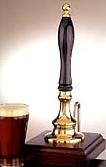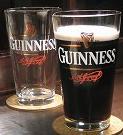|
 Measure for Measure Measure for Measure
|
|
The brewing industry helps preserve
good old British traditions by sticking
to good old-fashioned measuring systems for its products. It has the
useful side effect of confusing our Continental cousins and all those kids
educated in the post-decimalisation era - but none of them drink real beer, do
they??? |
 |
 If you ask for a beer in a (decent) pub, you'll normally be offered a
pint
or half pint,
hopefully of a good cask ale, delivered from a hand-pump on the bar, and served
in a glass which has been officially marked to show the appropriate measure. If you ask for a beer in a (decent) pub, you'll normally be offered a
pint
or half pint,
hopefully of a good cask ale, delivered from a hand-pump on the bar, and served
in a glass which has been officially marked to show the appropriate measure.
(And there are 8 pints in a gallon
- remember this, there will be questions later!) |
The beer will have been put into
casks at the brewery (not 'barrels' - see note below) These are the
containers in which it is delivered to the pub's cellar, and from which it is
drawn for dispensing at the bar by the pumps. The casks, normally made of
metal today, no longer wood, normally come in two sizes - the 9 gallon
firkin
and the 18 gallon kilderkin
|

|
The style of glass on the left - with
the fetching bulge part way down - is referred to as
Nonic. is referred to as
Nonic.
Then there's the
standard straight-sided type. |
 Other commonly
available styles are the Tulip . . . Other commonly
available styles are the Tulip . . .
 .
. . and the Dimple .
. . and the Dimple
|
If you want to strike up an
interesting - and long lasting - discussion in a pub, simply ask a couple of the
locals which shape of beer glass is best. That should while away a few
happy (or possibly heated!) hours.
And if conversation flags you can
always ask them if beer should be served with a good head of foam . . . |
|
So if beer comes in casks, don't
they use barrels any more?
|
Well, yes and no . . . Beer is
delivered in casks
of firkin
or kilderkin
size, because those are reckoned to be most convenient for sales purposes -
and in these days of strict Health and Safety rules they are also less
likely to give the drayman or cellarman a hernia! |
But the old
barrel
(measuring 36 gallons) still survives in a notional form because that is how
the output of a brewery is assessed - one with a 10 barrel plant can produce
360 gallons.
(End of term test - how many pints
is that?)
|
For those who really enjoy the
details - or are simply masochists looking for a quick headache - an
Imperial British Gallon
was defined as the volume occupied by exactly 10 pounds of water of density
0.988859 gramme per millilitre weighed in air of density 0.001217 gramme per
millilitre against weights of density 8.136 grammes per millilitre - got
that?
|
And if you still haven't got the
headache you were seeking, be aware that the capacity of a barrel has been
defined in different ways over the years, being 31.5 gallons if it held
wine, but 32 gallons when the contents were classed as ale and 36 gallons
when beer!
|
|
Now lets put it all together -
and throw in a few more to make confusion complete. |
One
Fluid Ounce (Fl. oz)
is 1/160 of a Gallon
One Gill
is 5 Fl. oz or 1/32 of a Gallon
One Pint
is 4 Gills or 20 Fl. oz or 1/8 of a Gallon
One Quart
is 2 Pints or 8 Gills or 40 Fl. oz or 1/4 of a Gallon
There is also a Pottle,
which is 2 Quarts or 4 Pints.
I've never heard it used but it's an attractive thought:
"Ho there, mine host, a
pottle of your best ale!"
Must try that in my local sometime . . .
|
One
Firkin
is 9 Gallons
One Kilderkin
is 2 Firkins or 18 Gallons
One Barrel
is 2 Kilderkins or 36 Gallons
In the wine trade they still use
Hogshead, where it means 63
Gallons, but in the brewing industry it used to refer to 1.5 Barrels=54
Gallons.
Similar disagreement exists with
Pipe or
Butt
(126 Gallons of wine, but 3 Barrels=108 Gallons of beer). And although
both trades agree that a Tun
or Ton
is 2 Pipes, that works out at 252 gallons of wine but 216 of beer! |
 Measure for Measure
Measure for Measure

 is referred to as
Nonic.
is referred to as
Nonic.
 Other commonly
available styles are the Tulip . . .
Other commonly
available styles are the Tulip . . . .
. . and the Dimple
.
. . and the Dimple